Archived Water Damage Blog Posts
Check your appliances!
10/16/2024 (Permalink)
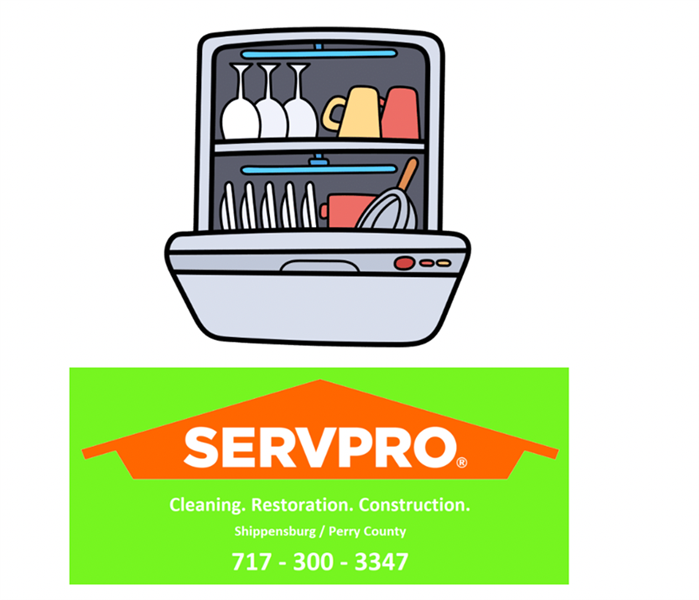 dish washer and our logo
dish washer and our logo
How often do you check your supply line to your appliances? It is a good idea to check them on a regular basis to ensure there are no leaks, worn spots, or that a pest has chewed them. We helped a customer who had a slow leak that was not caught until the homeowner was sitting in her basement family room watching tv when water started to drip from the ceiling. It didn't take long to figure out that the dishwasher had a very slow leak. This leak got under the vinyl flooring in the kitchen which also soaked into the bottom of her cabinets and eventually down through the floor and insulation in the basement causing the drip that caught her eye. When we arrived on site, the homeowner's sons had already tore out the vinyl and set up a few small fans to help start the drying process, saving us time to where we could just set up equipment and get the drying process underway with our professional grade equipment.
A Lot of Water Damage Can Occur in the First 24 Hours of a Water-loss
9/10/2024 (Permalink)
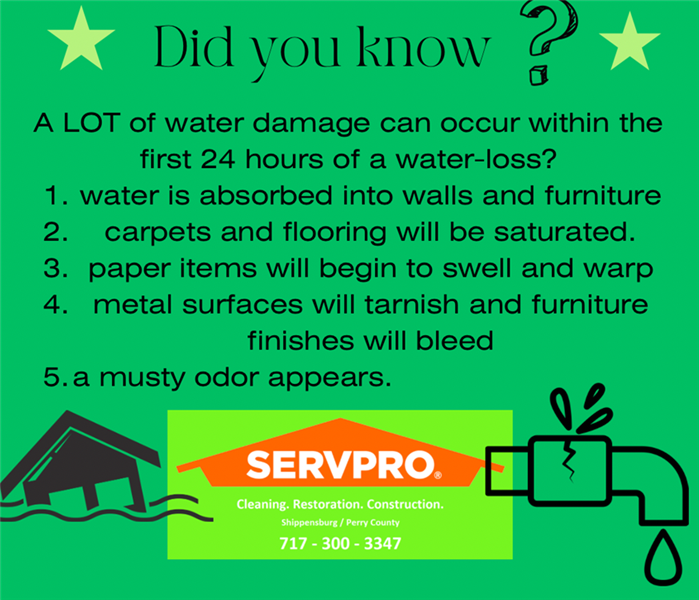 A graphic that explains the damages that can occur in the first 24 hours of a water-loss
A graphic that explains the damages that can occur in the first 24 hours of a water-loss
Unfortunately a lot of damage can occur in a very short amount of time when a water-loss happens in your home. What is a water-loss? A pipe breaking or leaking is considered a water-loss. The following are 5 things that can occur in the first 24 hours of a water-loss.
1 . Water is absorbed into walls and furniture.
2. carpets and flooring will be saturated.
3. Paper items will begin to swell and warp
4. metal surfaces will tarnish and furniture finishes will bleed.
5. A musty odor will appear.
It is of utmost importance to give us a call as soon as a water-loss occurs.
Water Damage Restoration 101 | SERVPRO® of Shippensburg/Perry County (717)-300-3347
10/10/2023 (Permalink)
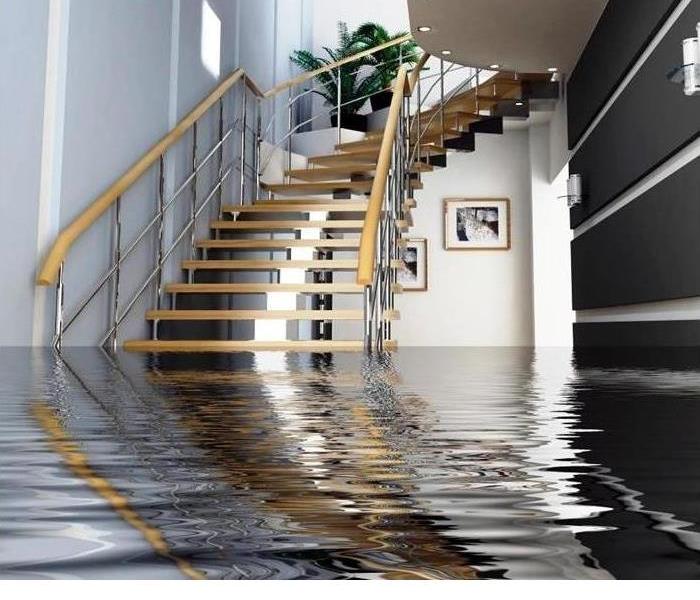 When experiencing water damage call | SERVPRO® of Shippensburg/Perry County (717)-300-3347
When experiencing water damage call | SERVPRO® of Shippensburg/Perry County (717)-300-3347
When your home is being threatened by water damage from flooding or leaks, SERVPRO of Shippensburg/Perry County Professionals have the expertise to prevent or mitigate the devastating effects water damage can have in order to help preserve and restore your property.
Our Professionals have the equipment and experience necessary to handle the most challenging water damage and removal situations and are available around-the-clock. We concentrate on safely drying, deodorizing and disinfecting the areas flooded or damaged by water, utilizing the following:
Water Removal Equipment
- Moisture detectors, hygrometers and other meters measure the extent of moisture saturation.
- Infrared camera may be used to identify water location for thorough water removal.
- Submersible and gas-powered pumps for continuous pumping of high-level water.
- Truck mounted and portable extraction units perform efficient water removal.
Sanitizing Agents, Germicides, & Anti-Microbial Treatments
- Deodorization products control odors from excessive moisture.
- Disinfection products stop the growth of bacteria, fungi, mildew, and other harmful microorganisms.
Hi-Tech Drying Equipment
- Drying equipment helps prevent property water damage like swelling and warping of floors, walls and furniture.
- Industrial grade dehumidifiers minimize secondary water damage.
- High-speed air movers create airflow across walls, carpets, pads and furniture, evaporating moisture.
- Some situations call for special drying techniques that require state of the art equipment and training.
Our Professionals are ready to respond 24/7 to mitigate any size loss in the Shippensburg area call
| SERVPRO® of Shippensburg/Perry County (717)-300-3347
Flood Watch vs Flood Warning | SERVPRO® of Shippensburg/Perry County 717-300-3347
9/13/2023 (Permalink)
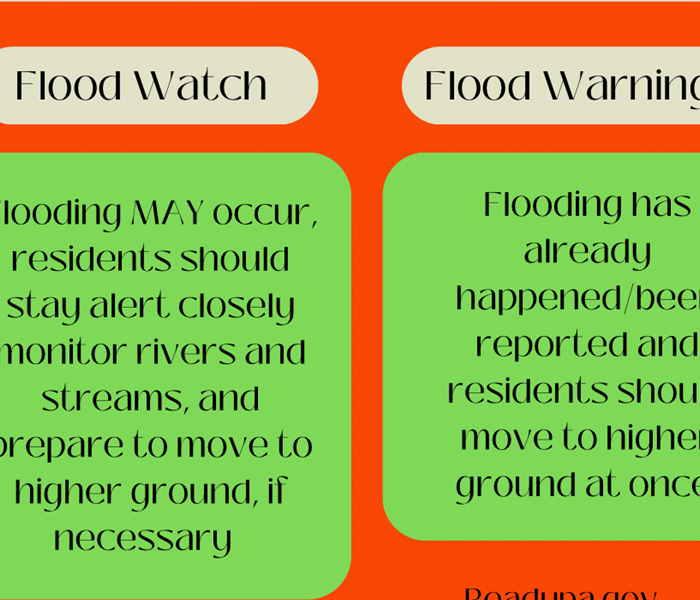 SERVPRO of Shippensburg/Perry County 717-300-3347
SERVPRO of Shippensburg/Perry County 717-300-3347
Know the difference in flood prediction terminology - especially if you love in an area that is prone or susceptible to periodic flooding.
What You Can do to Stay on Top of Commercial Water Damage | SERVPRO® of Shippensburg/Perry County
10/21/2022 (Permalink)
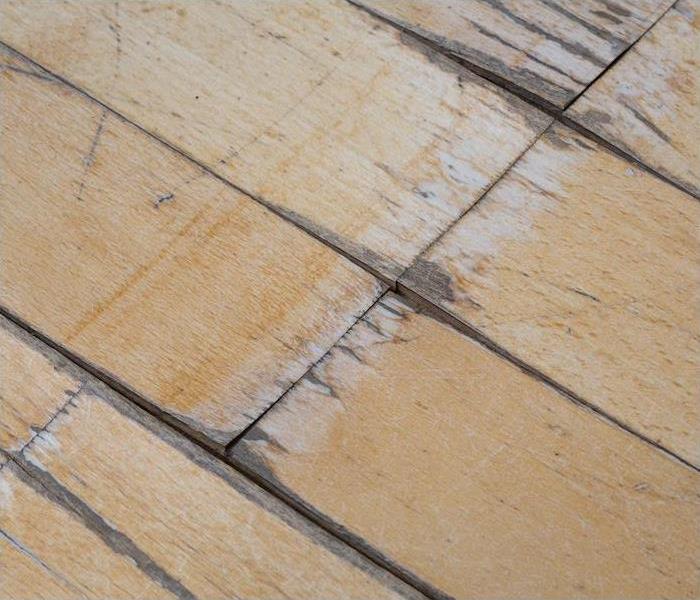 SERVPRO of Shippensburg/Perry County are your local commercial restoration company. We will always be here to help and get you back in business.
SERVPRO of Shippensburg/Perry County are your local commercial restoration company. We will always be here to help and get you back in business.
The results can be devastating when your business is suddenly impacted by water damage.
Flooding can originate from many places inside your building. Internal sources like a busted pipe or a leaky roof can halt productivity and ruin every inch of your commercial property. Natural causes like inclement weather can even more destroy your business when you least expect it.
Strong storms, heavy rainfall and nearby hurricanes all create flash floods in Shippensburg/Perry County. Situations like this hit our local businesses hard and can leave them vulnerable to even more damage in the future.
Knowing what to do when these emergencies occur can help you deal with the remnants of a disaster much more easily. This guide will enable you to take care of any disaster as quickly as possible so your business doesn’t suffer too much damage.
Know Your Building’s LayoutLocate the main water cutoff points around your building. Knowing how to find and shut off sources like your fire sprinkler or the main water valve will allow for a much quicker response and the mitigation of water damage.
Make sure to pass this information along to trusted members of your team and run them through this process. The more people who understand how to stop water at the source, the less damage your building will sustain.
Know the Types of Water InvolvedThe type of water produced when water damage strikes can help you understand the severity of the situation. Understanding what kind of water has flooded your property will allow you to take adequate measures.
White water: Plumbing failures are typically to blame for this kind of water. You can safely manage this water yourself in tiny quantities and is not regarded as contaminated.
Gray water: This kind of flooding is caused by overflowing toilet tanks and sink drains. Although it’s contaminated, this water is not recognized as hazardous.
Black water: Heavily contaminated black water is frequently produced by sewage blockages and storm flooding. This dangerous water should be handled by a trained professional.
Take Action QuicklyWhen dealing with water damage, you need to find the water source and swiftly turn it off. Open windows and doors to allow your building to dry a bit faster. After that, inform everyone inside the structure that the impacted areas are off-limits.
After getting the emergency under control, record any damage around your building. This will facilitate filing your insurance claim and be useful when determining which areas of your building require the most strengthening.
Remember to Be PatientOnly a portion of your building’s total concern is represented by the apparent water damage. It’s possible that you have hidden water damage without even being aware of it.
When water infiltrates your commercial property, SERVPRO of Shippensburg/Perry County is the team to call. Our experienced repair crew can thoroughly dry out your building using cutting-edge tools and rapidly complete a full restoration.
While our team works to repair your building, we’ll keep you to informed throughout the entire process. As soon as we are complete, you and your team will be safe to get back to work!
When disaster strikes your commercial property, we’ll be there to help clean up and get you back in business quickly. Reach out 24⁄7 to get started!
The 3 Major Sources of Storm Damage | SERVPRO® of Shippensburg/Perry County
9/1/2022 (Permalink)
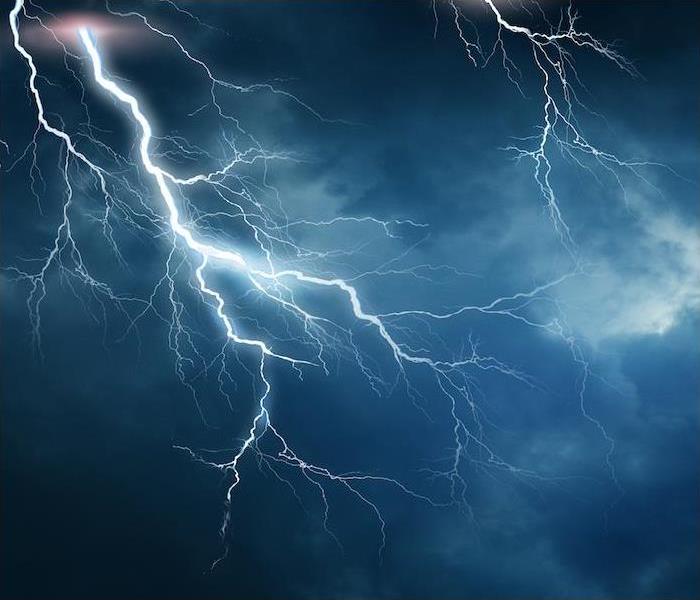 When you suffer storm-related damage to your home or business, make SERVPRO of Shippensburg/Perry County your first call.
When you suffer storm-related damage to your home or business, make SERVPRO of Shippensburg/Perry County your first call.
Severe storms can be devastating for homeowners and can lead to costly damage that must be repaired. While some homeowners believe their home is prepared for this severe weather, many times they are proven wrong when an extreme storm passes through and creates significant losses inside and outside their property.
Strong winds and weather-related calamities can throw around debris as well as create heavy rains, hail storms, lightning and floods. Depending on the season and the type of storm, they are all a threat to your home and any of your belongings.
Depending on the kind of storm and events taking place, your home may be subject to different degrees of destruction. Multiple elements play a part in determining the intensity of potential damage, like the landscape around your property, the geography of the area and the quality of your home’s foundation or building materials. (We’re not going to deny that there is an element of chance as well.)
Being knowledgeable about the many kinds of weather threats is helpful, but understanding the specific conditions that frequently affect our area is even more beneficial. Lebanon faces thunderstorms, winter storms and flooding frequently. This weather has led to significant damage to properties all over our area.
To better prepare you for extreme weather, let’s examine the three primary types of storm damage:
Wind
When structures are subjected to powerful gusts of wind at extraordinarily high speeds, this type of destruction ensues. Tornadoes and hurricanes are the most common causes of strong winds, but thunderstorms can produce gusts of up to 100 mph.
Wind gusts might scoop up debris in your yard and toss it into your car or house. And the wind itself can also be powerful enough to rip shingles off the roof. It is critical to remain inside when a storm is on the way and away from any windows or outside walls in case glass breaks or the walls are pierced by debris.
Prepare your yard before a storm touches down to prevent excessive damage due to wind. Clean up any branches, large rocks, unsecured furniture or decaying trees to give strong wind gusts less to work with once they start blowing.
Water
Water damage is known to cause costly damage inside homes before and after a storm. Even a small storm can produce rain showers that cause water to collect outside your home and then leak inside through the seals on your doors and windows.
When there is a significant amount of water, it may soak into your foundation and seriously destroy its structural integrity.
Try utilizing strategic landscaping methods that help to direct water away from your property to minimize the degree of damage that water may do to your property. Alternatively, you could build a rain garden, which will help prevent water from accumulating near your home and make it look beautiful at the same time!
Also, be sure to keep your gutters clear of debris so they function as intended during severe weather. Clogged downspouts create backed-up water, which builds up until it eventually begins to leak down into your home.
Impact
“Impact damage” is another form of storm destruction that can have a devastating effect on your home. This damage presents itself as downed trees or debris being thrown into your home by heavy winds. Impact damage encompasses any damage done when an object hits or impacts your house or property.
To best avoid this type of damage, trim any branches that are near your home and have any decaying trees removed. This will prevent Mother Nature from sending them down onto your property.
Weather-related calamities cost more than $145 billion in losses in 2021 in the United States alone. These methods could help you save a significant amount of time and money and can help you prevent damage from occurring before a storm gets the chance to wreak havoc on your home.
Give SERVPRO of Shippensburg/Perry County a call immediately if your household faces the devastating impact of severe storms. With state-of-the-art equipment and years of experience, our restoration specialists can handle any tragedy.
When you suffer storm-related damage to your home or business, it’s important that you know who to call! Contact us today to get your storm damage restoration started faster.
How Can I Tell if My Basement Has Water Damage? | SERVPRO® of Shippensburg/Perry County
7/1/2022 (Permalink)
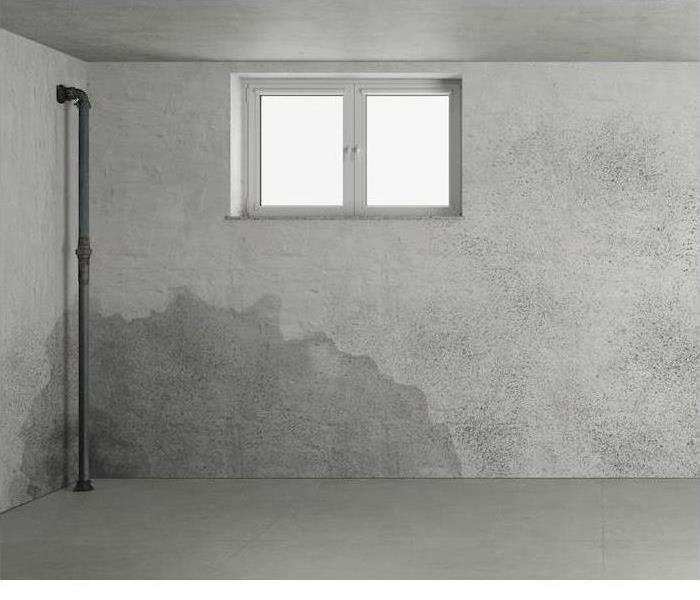 If you have experienced any signs of water damage in your basement, give SERVPRO of Shippensburg / Perry County today! 717-300-3347
If you have experienced any signs of water damage in your basement, give SERVPRO of Shippensburg / Perry County today! 717-300-3347
Basements are a wonderful addition to any home. While it’s a great place for additional storage, a “bonus” room or an at-home gym, it can also act as a safe place to go during the event of seriously inclement weather.
However, due to the nature of how basements are dug into the ground, they can come with their own challenges, particularly water damage. While it’s not a guarantee that your basement will suffer water damage, many homes do for a variety of reasons.
Because of this, it’s good to be extra vigilant for signs of water damage so that you can prevent any further damage later on. Here will be looking at some signs of water damage so that you can keep your basement in peak condition.
3 Top Signs That There Is Water Damage In a Basement
Musky, unpleasant odors. Water that gets into a basement can remain stagnant for quite some time, and when it evaporates, it can leave quite an unpleasant smell. This pungent odor is almost exclusively caused by mold and mildew in the environment, so if you suspect that it’s just the common “musty smell” that most basements have, remember that this is a common misconception and it may be a serious red flag leading to water damage.
Flaking paint from the walls. Waterproof paint is sometimes adhered to interior basement walls and masonry with all good intentions by homeowners and landlords. However, this paint can oftentimes simply mask any issues related to water damage and results in compounded problems later on. Even though it’s classified as waterproof, it’s still possible for this paint to chip, peel and bubble on the surface under the right circumstances.
Foundational cracks. Cracks in homes can sometimes be caused by the house settling over time, but finding cracks in the foundation should be investigated as it may be a sign of water damage. Hairline cracks aren’t a major cause for immediate concern, but if they grow in size or width, they should be seen and treated by a professional immediately.
If you have experienced any of these signs of water damage in your basement, give us a call. We’ll be happy to have our water restoration technicians review the damage and give you an assessment on how we can help treat it properly. Contact SERVPRO of Shippensburg/Perry County today! 717-300-3347
Don’t Overlook the Water Damage Risks Heavy Rain Can Bring | SERVPRO® of Shippensburg / Perry County
6/24/2022 (Permalink)
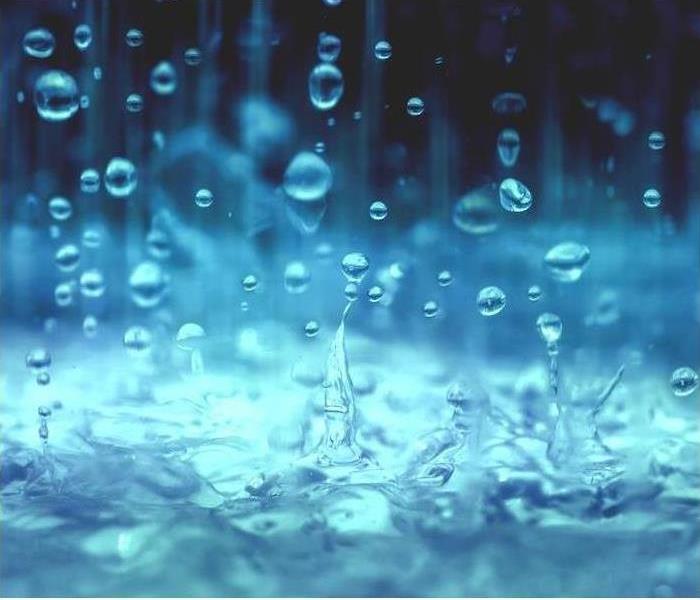 SERVPRO of Shippensburg / Perry County is here to help restore your home to its original state. Contact us today! (717) 300-3347
SERVPRO of Shippensburg / Perry County is here to help restore your home to its original state. Contact us today! (717) 300-3347
Heavy rains might not be the first thing you think about when you list water damage causes. But it can be a serious problem for homeowners. Rain is common during the spring and summer months, and if your home is not properly maintained, these rains can cause costly damage.
It’s not as difficult as you might think to lessen your risk, though. A little creativity and some thoughtful planning can go a long way.
Protecting Your Home From the Hazard of Heavy Rains
We have a wealth of experience dealing with home water damage. We know what causes it and what you can do to make your home safer from it.
Here are some things we think you should keep in mind when you want to protect your home from rain damage:
Don’t allow yard drainage issues to go unaddressed. If you realize the water in your yard drains toward your home, it’s time to invest in your yard to help it move water more efficiently. Water moving away from your home is water that can’t damage it. Talk with a landscaping expert about how you can protect your yard.
Choose your flowers and shrubs for more than curb appeal. Most homeowners don’t look beyond the visual appeal of the landscaping they choose. But your landscaping can do more for you than just add color. Native plants are especially effective when it comes to making your landscaping an extra layer of water damage protection.
Repair loose and missing shingles. How important is repairing your roof when it suffers minor damage? The answer is very important. According to industry experts, 95% of damage is caused by water finding its way through gaps in your shingles. This damage is preventable.
If you need help dealing with damage caused by water, fire or any other issue, SERVPRO of Shippensburg / Perry County is here to help you restore your home. We have crews who are available 24⁄7 in the event of an emergency.Contact us at any time to learn more about us and how we can help you restore your home to its original state.
Keep an Eye Out for Flooding | SERVPRO® of Shippensburg/Perry County
4/5/2022 (Permalink)
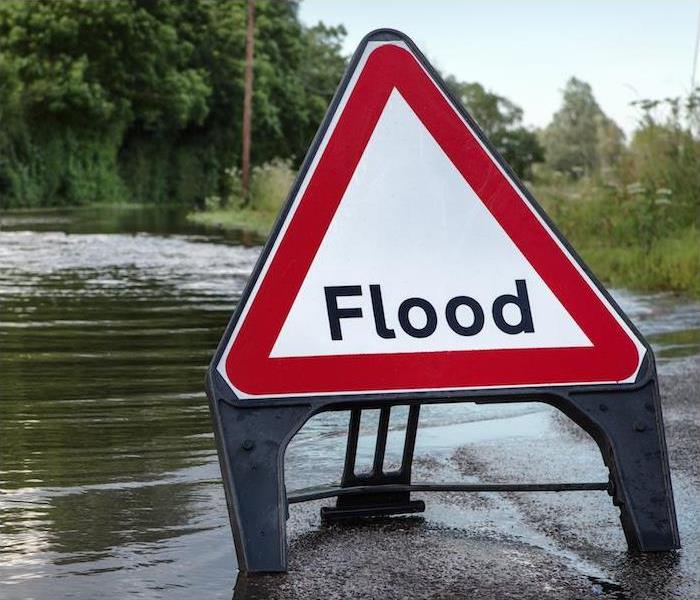 Regardless of the cause of the flooding, SERVPRO of Shippensburg/Perry County has the team to help you recover from any disastrous event.
Regardless of the cause of the flooding, SERVPRO of Shippensburg/Perry County has the team to help you recover from any disastrous event.
Did you know flooding is the most common natural disaster, claiming more lives in the United States per year than hurricanes, tornadoes or lightning? Flooding is difficult to predict and can destroy anywhere from a single home to entire communities.
Although floods affect every state and territory in the United States, they share many similarities in types and causes. There are just a few types of natural flooding you may see throughout the year.
Types of Natural Flooding
Flash floods are common, and they happen when heavy rain passes or sits over an area and overwhelms the ability of the ground to contain the moisture. Flash flooding can strike alone or accompany a larger problem, such as a hurricane. In 2021, Hurricane Ida dumped multiple inches of rain at once, leading the National Weather Service to release several Flash Flooding Emergencies.
River floods are exactly what they sound like. When there’s too much water for a river’s banks to hold, the water spills over the sides and causes destruction.
Coastal floods happen in areas next to large bodies of water, when storm surges or cyclonic activity causes ocean or gulf levels to rise to flood levels.
Common Causes of Natural Flooding
Heavy rainfall. Storms with excessive rainfall, or storms that sit and rest over an area for an extended period can cause flash floods or river flooding. Urban areas are more at risk for rain floods, because the higher percentage of concrete and asphalt means there’s a lack of soil to soak up all that water.
Oceanic activity. Storm surges, hurricanes and rising tides can cause water levels to rise in waves, which can invade coastal communities and wreak havoc. Pennsylvania, as a water-adjacent state, is susceptible to the fury of storm surges and hurricanes. Most recently, Hurricane Ida dumped multiple inches of rain on central Pennsylvania, leading to flooded roads and creeks.
Dams and levees failing. The most notable example of this in recent history would be the disastrous levee breaks during 2005’s Hurricane Katrina. Levees and dams fail when cracks occur or excess pressure overtakes the dam’s ability to contain the surge of water behind it.
Snowmelts and ice dams. In areas of the country where heavy snow and prolonged freezing temperatures are common, snow and ice can build up over a winter’s time, and when they start to melt, they cause rivers of water to flow through area communities. Ice dams or ice jams happen when rivers become blocked by built-up ice being carried downstream, causing the banks to overflow.
Regardless of the cause of the flooding, SERVPRO has the tools and teams to help your home or business recover from its disastrous effects. Contact us anytime when flooding or water damage makes a mess in your life.
Water Damage Numbers That Will Wow You | SERVPRO® of Shippensburg/Perry County
12/10/2021 (Permalink)
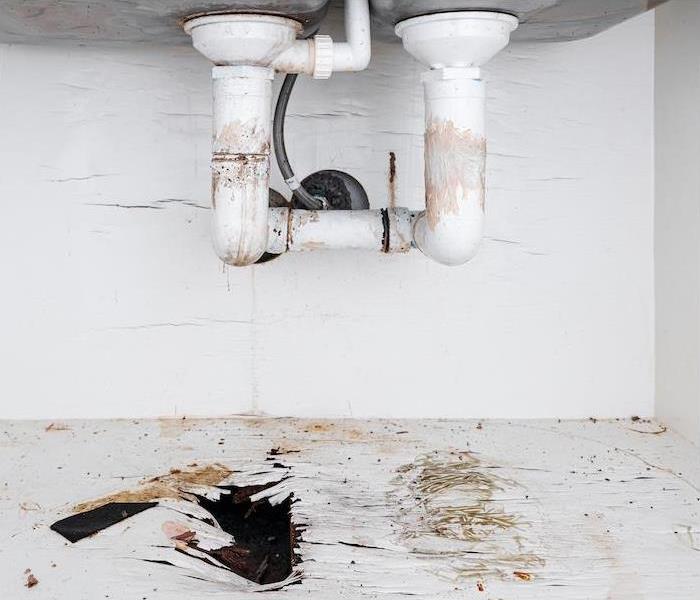 If water damage catches you off-guard and leaves you all wet, you’ve got help on your side. Contact SERVPRO of Shippensburg/Perry County.
If water damage catches you off-guard and leaves you all wet, you’ve got help on your side. Contact SERVPRO of Shippensburg/Perry County.
Not to cause alarm, but there’s a struggle coursing through your home right this very moment, wherein a squadron of heavily armored heroes at working their hardest, holding at bay a destructive force that could devastate your peaceful abode.
This struggle, of course, is between your plumbing and the water it transports. You guessed it right away, didn’t you?
Your water supply is great, so long as it’s serving its proper purpose. But the minute it breaks containment, you’ve got a problem. That’s why it’s all-important to have a well-equipped and maintained plumbing system—so that the good guys always stay on top.
The widespread damage done by water in the home is overwhelming—check out these numbers.
24. This is the percentage of all U.S. home insurance claims that are water-involved. That’s one out of every four claims, which adds up to one in 50 homeowners filing a water claim every single year.
48. You have this many hours (or less) to deal with a water damage incident before mold sets in. Mold growth begins rapidly once water soaks into a surface, and it’s present well before you can make it out with your eyes.
98. This one’s admittedly a little disheartening, because it represents the number out of every 100 basements that will flood or experience water damage at some point in the life of a home. If there’s any number on this list you can almost count on, it’s this one.
10,234. The amount of the average water claim. Water is fast to take over a whole area, and it can settle in and do a lot of damage very quickly. Once it gets out, your insurance company is likely to have to shell out more than they’d hope to manage repairs.
14,000. If you have today’s date circled on your desk calendar, look down and try to imagine 14,000 little dots inside it, each of them representing a single water claim that will happen somewhere in the United States today, because that’s what’s going to happen. Every six seconds, a new event is occurring.
13,000,000,000. Those zeroes are not a typo—that’s 13 billion, and it represents the amount, in dollars, spent every year on water damage repairs in homes.
All these numbers serve to show you one thing: It’s incredibly important to take care of leaks early, and to maintain and update your plumbing, sewage and water systems. The more you can do to avoid being one of these statistics, the better.
If water damage catches you off-guard and leaves you all wet, you’ve got help on your side. Contact SERVPRO to see how we can quickly and fully restore water damage to your home or business.
Where You Might Find Water Damage at Home | SERVPRO® of Shippensburg/Perry County
9/9/2021 (Permalink)
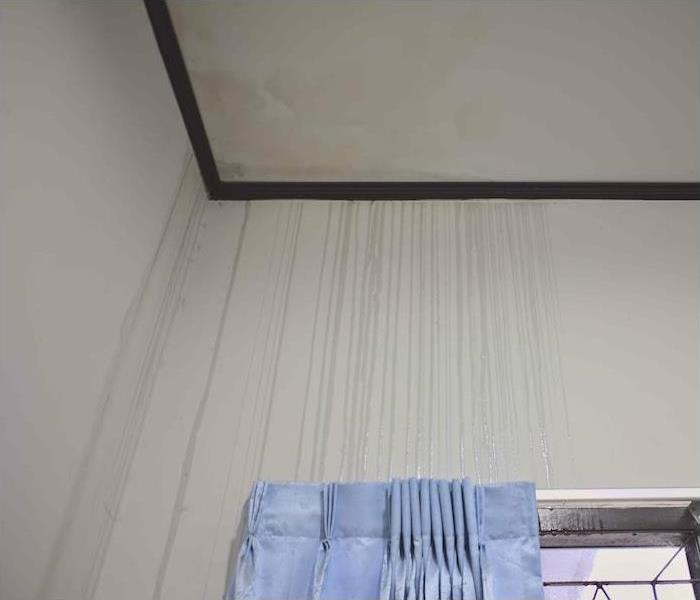 A water leak can turn into a big problem. Contact the SERVPRO of Shippensburg/Perry County team if you are dealing with any water damage.
A water leak can turn into a big problem. Contact the SERVPRO of Shippensburg/Perry County team if you are dealing with any water damage.
There’s a fair chance you didn’t go to bed last night wishing upon a star that you could wake up this morning to a flooded garage. Dealing with unexpected water damage is on no homeowner’s list of hopeful tasks.
Obviously we can’t predict external factors like flooding, but there are some places in and around your home that you may be able monitor and gain an advantage as you try to keep the likelihood of water damage to a minimum.
Toilets. There are a few spots in this oft-used appliance that can degrade over time, namely the flapper inside the tank and the valve seal under it. These being rubber makes them prone to wear.
Appliances. Toilets, dishwashers, fridges and any appliance that uses water or feeds from your water supply are prone to leaks, especially from hoses that may dry out or crack, and joints where washer rings may decay. And how old is your water heater? Units over 10 years old have actually been known to explode.
Clogged gutters. This is the most preventable leak at home. Some time on the ladder can keep your gutters in tip-top shape and keep leaves and dirt from damming up the gullies and sending water inside.
Roof damage. Roof care is a whole other topic, but for now, let’s simply say that your roof is an incredibly important source of protection from the elements, and keeping it in good condition will help keep your interior dry. Inspect it regularly and after any major storm.
Pipes. Rust, faulty joints or even excessive water pressure can cause pipes to fail or burst, and tree roots can find microscopic cracks in outdoor lines, even your main water supply.
Blocked garbage disposals or other pipes.Putting the wrong things down your disposal can either cause your disposal to stop working or clog your pipes to the point of backup. Anything that clumps, solidifies or expands as it soaks up water is a no-no.
Water leaks can occur anywhere water flows, because water will find and take advantage of any available space. But keeping an eye on these common leak areas may help you stay ahead of the potential for water damage in your home.
If a water leak erupts into a big problem at home, you’ve got the best team in the business on your side. Contact SERVPRO today so we can get started.
Water Damage Days Before a Wedding
8/9/2021 (Permalink)
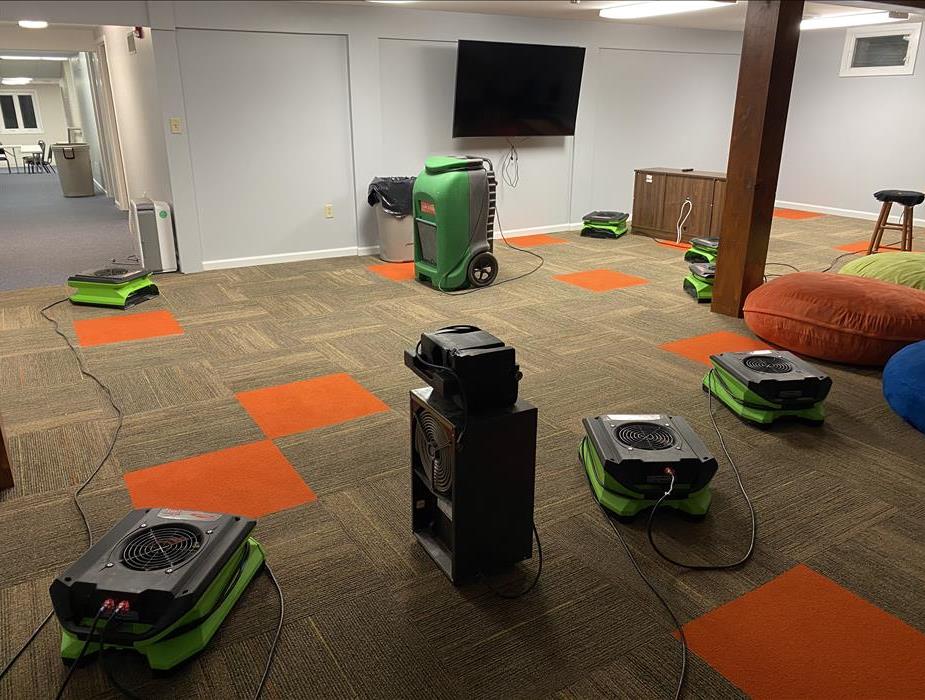 SERVPRO of Shippensburg/Perry County responds to Speedwell Heights BIC Church days before a wedding.
SERVPRO of Shippensburg/Perry County responds to Speedwell Heights BIC Church days before a wedding.
Days before a wedding event, Speedwell Heights BIC contacted SERVPRO of Shippensburg/Perry County about their water damage in the basement. The source of this damage came from a defective dehumidifier that leaked water in the basement of the church. SERVPRO of Shippensburg/Perry County quickly responded to this call on a Thursday. Our technicians were able to dry everything out and deodorize in time for the wedding that following Saturday.
When dealing with a water damage, it is important to act fast to prevent further damage and possible mold growth. Our highly trained technicians will have your home or business “Like it never even happened.” Contact SERVPRO of Shippensburg/Perry County at 717-300-3347 or visit our website for all of your water damage needs.
How Can I Tell if My Basement Has Water Damage? | SERVPRO® or Shippensburg/Perry County
7/1/2021 (Permalink)
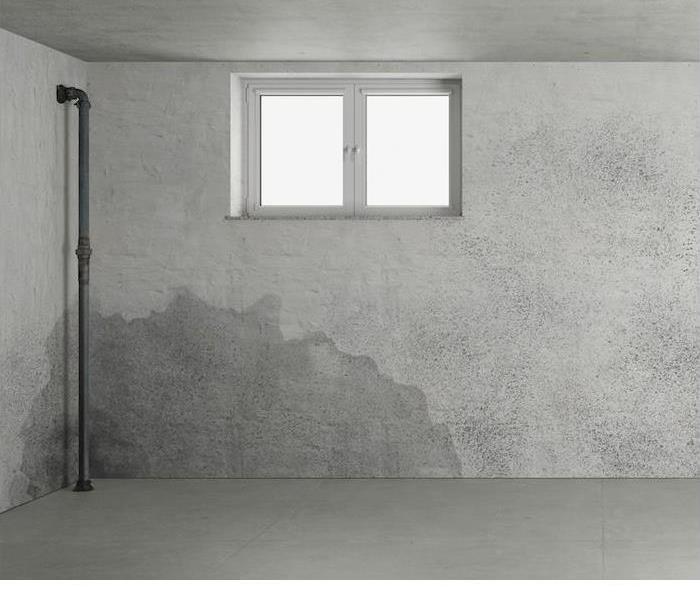 Signs of water damage in a basement
Signs of water damage in a basement
Basements are a wonderful addition to any home. While it’s a great place for additional storage, a “bonus” room or an at-home gym, it can also act as a safe place to go during the event of seriously inclement weather.
However, due to the nature of how basements are dug into the ground, they can come with their own challenges, particularly water damage. While it’s not a guarantee that your basement will suffer water damage, many homes do for a variety of reasons.
Because of this, it’s good to be extra vigilant for signs of water damage so that you can prevent any further damage later on. Here will be looking at some signs of water damage so that you can keep your basement in peak condition.
3 Top Signs That There Is Water Damage In a Basement
Musky, unpleasant odors. Water that gets into a basement can remain stagnant for quite some time, and when it evaporates, it can leave quite an unpleasant smell. This pungent odor is almost exclusively caused by mold and mildew in the environment, so if you suspect that it’s just the common “musty smell” that most basements have, remember that this is a common misconception and it may be a serious red flag leading to water damage.
Flaking paint from the walls. Waterproof paint is sometimes adhered to interior basement walls and masonry with all good intentions by homeowners and landlords. However, this paint can oftentimes simply mask any issues related to water damage and results in compounded problems later on. Even though it’s classified as waterproof, it’s still possible for this paint to chip, peel and bubble on the surface under the right circumstances.
Foundational cracks. Cracks in homes can sometimes be caused by the house settling over time, but finding cracks in the foundation should be investigated as it may be a sign of water damage. Hairline cracks aren’t a major cause for immediate concern, but if they grow in size or width, they should be seen and treated by a professional immediately.
If you have experienced any of these signs of water damage in your basement, give us a call. We’ll be happy to have our water restoration technicians review the damage and give you an assessment on how we can help treat it properly. Contact SERVPRO of Shippensburg/Perry County today!
Appliance Leaks
4/18/2018 (Permalink)
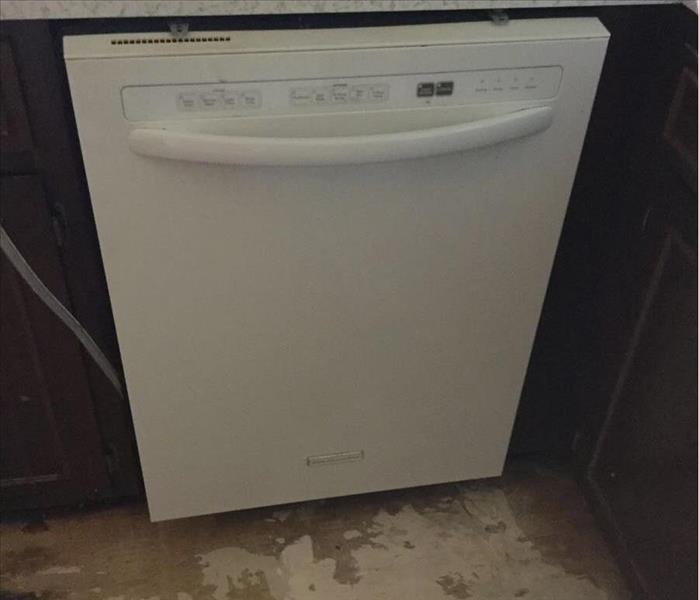 Dishwasher that caused a water damage
Dishwasher that caused a water damage
How often do you check your supply line to your appliances? It is a good idea to check them on a regular basis to ensure there are no leaks, worn spots, or that a pest has chewed them. The attached picture from SERVPRO of Shippensburg/Perry County shows a dishwasher that had a slow leak that was not caught until the homeowner was sitting in her basement family room watching tv when water started to drip from the ceiling. It didn't take long to figure out that the dishwasher had a very slow leak. This leak got under the vinyl flooring in the kitchen which also soaked into the bottom of her cabinets and eventually down through the floor and insulation in the basement causing the drip that caught her eye. When we arrived on site, the homeowner's sons had already tore out the vinyl and set up a few small fans to help start the drying process, saving us time to where we could just set up equipment and get the drying process underway with our professional grade equipment.





 24/7 Emergency Service
24/7 Emergency Service












